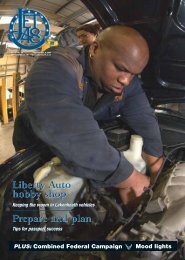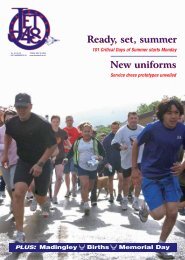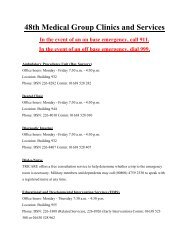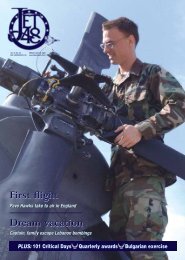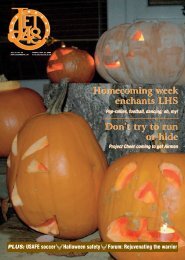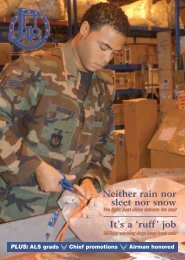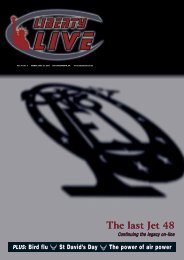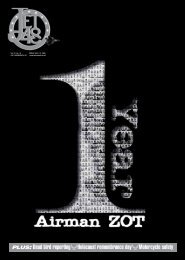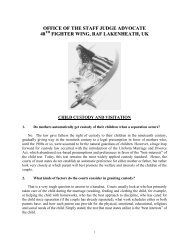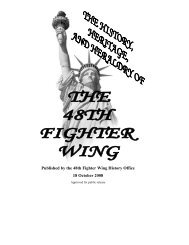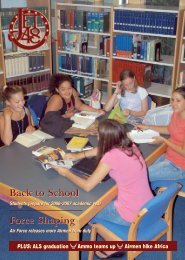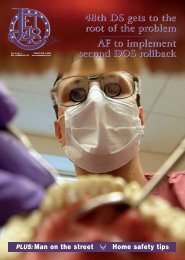By Sal Davidson – Community Relations AdviserTrooping the colours, the Queen’s birthdayThe official birthday of the Sovereign will be marked by a colourfuland historic military parade and march-past, known as Trooping theColour, on June 17. Trooping the Colour takes place each June on HorseGuards Parade, Whitehall, in front of crowds of onlookers. It is alsoenjoyed by millions world-wide on TV. The troops participating in theparade are drawn from a military organisation which, though a part of theArmy and therefore composed of fully trained, operational troops, is anational institution - the Household Division.It’s The Queen’s Colour of a Foot Guard battalion which is ‘trooped’each year before the Sovereign. Only one colour can be trooped, carriedalong the ranks, at a time, and the five Regiments – Grenadier, Coldstream,Scots, Irish and Welsh – taketheir turn year by year.The ceremony derives fromtwo old military ceremonies -Trooping the Colour andMounting The Queen’s Guard.The origin of the ceremony goesback to the early eighteenth century,and possibly even earlier,when the guards and sentries forthe Royal Palaces and otherimportant buildings in the capitalwere mounted daily on theparade ground by the HorseGuards building. A feature ofguard mounting was for thecolours (or flags) of the battalion,which are symbols of honour, butalso in the past served as rallyingpoints in battle, to be carried or‘trooped’ slowly down the ranksso it could be seen and recognised by the soldiers. In 1748, it was orderedthat this parade would also mark the official birthday of the Sovereign.From the accession of George IV the parade became, with a few exceptions,an annual event.Because the Guards, both Horse and Foot, are Household Troops whotraditionally have the honour of guarding the monarch, their link with theSovereign has been especially close. Until 1913, the normal procedure forguard mounting from Horse Guards Parade was marked on the officialbirthday of the Sovereign by the attendance of the King, Prince of theBlood Royal, visiting members of foreign Royal Families, the ArmyCouncil and other senior officers, and a large number of foreign militaryattaches and members of the Royal Households. In 1907, when KingEdward VII arrived on the parade there were over fifty in his mounted procession.Over the years there have been many modifications to the procedure,but today’s ceremony is largely based on the format introduced by KingGeorge V in 1914.The Queen’s first appearance at the Trooping the Colour was in 1947,when she was Princess Elizabeth. This was the first Birthday Parade to beheld after the Second World War and she was mounted and in the uniformof Colonel of the Grenadier Guards. All ranks wore battledress except theSovereign’s escort of the Household Cavalry, mounted officers and membersof the regimental bands who were in service dress. The Princess worea blue uniform with a forage cap, which later became the style of theone worn by members of the Women’s Royal Army Corps. The Queen hasbeen at the saluting base every year of her reign with the exception of1955, when a national rail strike forced the cancellation of the parade.The scarlet tunic that was worn by the Queen when she rode on horsebackalways bore the badges and button groupings corresponding to theregiment whose colour was being trooped that year. Also, the plume onher tricorn hat changed to match the plume worn on the side of the guards’bearskins, the large black hats worn by the soldiers. The Queen is normallyaccompanied by The Duke of Edinburgh who wears the uniform of theColonel of the Grenadier Guards, and The Prince of Wales, who wears theuniform of the Colonel ofthe Welsh Guards.From 1969 until 1986,the Queen rode a horsenamed Burmese, but sincethat time has arrived in aphaeton originally built forQueen Victoria in 1842. Sheno longer wears her uniforms,which were essentiallydesigned to wear onhorseback.The Band of theGrenadier GuardsIn 1685, during the reignof King Charles II and thesame year Handel and Bachwere born, music was introducedinto the Regiment byCourtesy photoRoyal Warrant.Authorisation was given for 12 Hautbois in the King’s Regiment ofFootguards in London. With the addition over the years of various instruments,by 1858 the Band sounded much as it does today and includesflutes, piccolo, clarinets, bassoons, French horns and trumpets among otherinstruments.Despite their musical prowess and impressive ceremonial role, everymember of the Band has another role. In the event of war, the Band providesessential enforcement as Medical Attendants. All have undergone alengthy and thorough initial course to train as “Medics” and annuallyundertake refresher training.Watching The Event:On Saturday, June 10 there is a rehearsal for the main ceremony. This iscalled ‘Colonel’s Review.’ This is exactly the same as the main parade butthis year HRH, The Prince of Wales is taking the salute. There is an offchance there could still be tickets for this so call (02079) 760 850 and theycan confirm availability. The tickets are £8.The main event gets sold out via ballot in January. and February. ofeach year so I hope those of you who want a birds eye view followed myadvice in the January article.People without tickets will be able to get a good view from the Malland also from St. James’ park but you have to be there early to secure aspot.PAGE 18 JET 48 MAGAZINE JUNE 9, 2006
Jet48CommunityMovies<strong>RAF</strong> <strong>Lakenheath</strong> 226-2139Today7 p.m., Slither, R. A small town in America—somewhatquaint and gentle, peopled with friendly folks who mindtheir own business. But just beneath the surface charm,something unnamed and evil has arrived and is growing.No one seems to notice as telephone poles becomeclogged with missing pet flyers, or when one of the town’srichest citizens, Grant Grant, begins to act strangely.9 p.m., Basic Instinct 2, R, starring Sharon Stone, DavidMorrissey After re-locating from San Francisco to London,best-selling crime novelist Catherine Trammell once againfinds herself on the wrong side of the law. Dr. MichaelGlass, a respected London criminal psychiatrist, is broughtin by Scotland Yard detective Roy Washburn to performa psychiatrist profile and evaluation of Tramell followingthe mysterious death of a top sports star.Saturday3:30 p.m., United 93, R, starring Ben Sliney and OpalAlladin. A drama that tells the story of the passengers andcrew, their families on the ground and the flight controllerswho watched in dawning horror as United Airlines Flight 93became the fourth hijacked plane on the day of the worstterrorist attacks on American soil: September 11, 20016:30 p.m., X-Men: The Last Stand, PG-13, The continuingadventures of the superpoweredgroup, the X-Men, led by ProfessorXavier, and based at hisschool for gifted students,as they try to foster goodwill for mutants like themselves,in a world wheresome people are born withextraordinary powers, andmany ordinary humansfear them for it.9:30 p.m., X-Men: TheLast Stand, PG-13Sunday3:30 p.m., X-Men: TheLast Stand, PG-136:30 p.m., Slither, RMonday6:30 p.m., ATL, PG-13starring Tip”T.I” Harris,Antwan “Big Boi” PattonATL tells the story of fourCourtesy graphicteens coming of age in a working class Atlanta neighborhoodwhere hip-hop music and roller skating rule. As thegroup prepares for life after high school, challenges onand off the rink bring about turning points in each of theirlives. The film is loosely based on Dallas Austin and TionneWatkins’ experiences growing up in Atlanta and hangingout at a local skating rink called Jellybeans.Tuesday6:30 p.m., X-Men: The Last Stand, PG-13Wednesday6:30 p.m., Basic Instinct 2, RThursday6:30 p.m., X-Men: The Last Stand, PG-13<strong>RAF</strong> Mildenhall 238-4955Today6:30 p.m., ATL, PG-139 p.m., The Da Vinci Code, PG-13, starring Tom Hanksand Jean Reno. The murder of a curator at the Louvrereveals a sinister plot to uncover a secret that has beenprotected since the days of Christ. Only the victim’s granddaughterand Robert Langdon, a famed symbologist, canuntangle the clues he left behind. The duo become bothsuspects and detectives searching for not only the murdererbut also the stunning secret of the ages he wascharged to protect.Saturday3:30 p.m., ATL, PG-136:30 p.m., The Da Vinci Code, PG-139 p.m., Slither, RSunday3:30 p.m., United 93, R,starring Ben Sliney andOpal Alladin. A drama thattells the story of the passengersand crew, theirfamilies on the ground andthe flight controllers whowatched in dawning horroras United Airlines Flight 93became the fourthhijacked plane on the dayof the worst terroristattacks on American soil:September 11, 20016:30 p.m., The Da VinciCode, PG-13MondayCourtesy graphic6:30 p.m., ATL, PG-13Tuesday6:30 p.m., Slither, RWednesday6:30 p.m., Basic Instinct 2, RThursday6:30 p.m., The Da Vinci Code, PG-13BULLETINBOARDBriefsAirmen’s <strong>Attic</strong>The Airmen’s <strong>Attic</strong> is now open Mondaythrough Thursday, from 5 until 8 p.m. TheAirmen’s <strong>Attic</strong> is only for servicemembers E-5and below and their family members. For moreinformation, call 226-2140.Women’s soccer team<strong>RAF</strong>s <strong>Lakenheath</strong> and Mildenhallwomen’s soccer team is looking for playerswho are over 18 years of age. For more information,call Airman 1st Class JenniferPuff at 226-8468 or e-mailjennifer.puff@lakenheath.af.mil.Car check upThe 48th Logistics Readiness Squadronvehicle maintenance flight will be inspectingvehicles at the commissary parking lot from7 a.m. until 1 p.m., today.They will provide a basic inspection,check the oil and fluids and give a quick lookunder the car. For more information, call226-3923.Sports announcer<strong>Lakenheath</strong> High School is recruiting anannouncer for football and basketball games.Prior experience and a knowledge of bothgames are preferred. For more information,call 226-1542.LES PTOThe <strong>Lakenheath</strong> Elementary School ParentTeacher Organization is looking for volunteersforthe 2006-2007 school year. The first boardmeeting is 6 p.m., Monday. For more information,e-mail omaira.ptso@gmail.com.CGOC crud tournamentThe Company Grade Officers Council ishosting a wing crud tournament at 4 p.m., June16 at the Eagles’ Landing. Standard prizes andfun are open to any team participating. Formore information, contact Capt. DustinRichards at 226-6034.United 93A free showing of United 93 will be heldat the <strong>RAF</strong> <strong>Lakenheath</strong> theater 3:30 p.m.,Saturday and at the <strong>RAF</strong> Mildenhall theater3:30 p.m., Sunday. This event is first come,first serve.Family Support CenterFor more information, call 226-3847Newcomers bus tourThe newcomers bus tour will be from8:45 a.m. until 2:30 p.m., today, June 16, 23 and30. The tour includes touring Bury St. Edmund’sCathedral, eating and shopping.Home buyingA stateside home buying seminar will be heldat <strong>RAF</strong> Mildenhall from 1 until 4 p.m., June 20.This class should be taken one year prior to aPCS move. Learn about preparing financially,finding that dream home, obtaining a mortgage,and closing the deal.Sponsor trainingSponsor training will be held from 1 until3 p.m., Monday. All first time active-dutysponsors and those who have not had trainingin more than a year are required to receivetraining.Financial readinessA financial readiness class will be held from9 until 10 a.m., Tuesday. This briefing ismandatory for all first duty station officers andall E-4 and below within two months of arrivalon station.Employment connectionsAn employment connections class will beheld from 9 a.m. until noon June 19 at <strong>RAF</strong>Mildenhall. This class will help people learnabout the local labor market and find out whatjobs are available on and off base. Personnelspecialists will be available to answer questionsconcerning hiring procedures and provide applicationsfor job vacancies.Love and logic parentingThe love and Logic parenting course will beheld 8:30 a.m. until 4 p.m., June 24. The classwill help ro taise children who are responsibleand respectful.PAGE 22 JET 48 MAGAZINE JUNE 9, 2006



